

A New Way to Detect Alzheimer's Years Before Symptoms Appear. Afflicting millions of patients, Alzheimer's disease is becoming a growing burden to healthcare systems around the world.
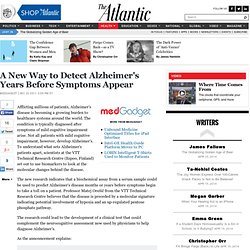
The condition is typically diagnosed after symptoms of mild cognitive impairment arise. Not all patients with mild cognitive impairment, however, develop Alzheimer's. To understand what sets Alzheimer's patients apart, scientists at the VTT Technical Research Centre (Espoo, Finland) set out to use biomarkers to look at the molecular changes behind the disease. Brain size may predict risk for early Alzheimer's disease. Progression to Alzheimer's Disease may be Predicted by Biochemical Signature.
Alzheimer's disease is preceded by a molecular signature indicative of hypoxia and up-regulated pentose phosphate pathway, a study led by Research Professor Matej Orešič from VTT Technical Research Centre of Finland suggests.
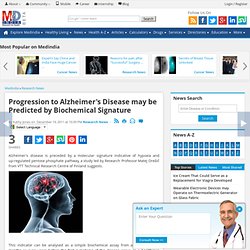
This indicator can be analysed as a simple biochemical assay from a serum sample months or even years before the first symptoms of the disease occur. In a healthcare setting, the application of such an assay could therefore complement the neurocognitive assessment by the medical doctor and could be applied to identify the at-risk patients in need of further comprehensive follow-up. Part Of Brain Associated With Delayed Disease Identified - Implications For Alzheimer's Disease. Alzheimer's drug candidate may be first to prevent disease progression. LA JOLLA, CA—A new drug candidate may be the first capable of halting the devastating mental decline of Alzheimer's disease, based on the findings of a study published in PLoS ONE.
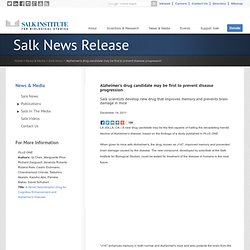
When given to mice with Alzheimer's, the drug, known as J147, improved memory and prevented brain damage caused by the disease. The new compound, developed by scientists at the Salk Institute for Biological Studies, could be tested for treatment of the disease in humans in the near future. "J147 enhances memory in both normal and Alzheimer's mice and also protects the brain from the loss of synaptic connections," says David Schubert, the head of Salk's Cellular Neurobiology Laboratory, whose team developed the new drug. Antioxidant has potential in the Alzheimer’s fight, UGA researchers find. Athens, Ga. - When you cut an apple and leave it out, it turns brown.

Squeeze the apple with lemon juice, an antioxidant, and the process slows down. Simply put, that same "browning" process—known as oxidative stress—happens in the brain as Alzheimer's disease sets in. The underlying cause is believed to be improper processing of a protein associated with the creation of free radicals that cause oxidative stress. Unexpected signaling role for foul-smelling hydrogen sulfide in cell response to protein misfolding. Cold Spring Harbor, NY -- Something rotten never smelled so sweet.

This is what members of a team of scientists at Cold Spring Harbor Laboratory (CSHL) are telling one another as they discuss a new finding they did not expect to make. They have discovered that hydrogen sulfide (H2S) – the flammable, highly toxic gas that we usually associate with the smell of rotten eggs in landfills and sewers – plays an important role in the regulation of a signaling pathway implicated in biological malfunctions linked to Alzheimer’s and Parkinson’s diseases, among others. Test for Alzheimer's disease predicts cognitive decline in Parkinson's disease. Public release date: 12-Dec-2011 [ Print | E-mail Share ] [ Close Window ] Contact: Kim Menardkim.menard@uphs.upenn.edu 215-662-6183University of Pennsylvania School of Medicine.

Research Shows Statins May Be Beneficial In Treating Alzheimer's Disease. Alzheimer's antibodies developed. Researchers at Rensselaer Polytechnic Institute have developed a new method to design antibodies aimed at combating disease.
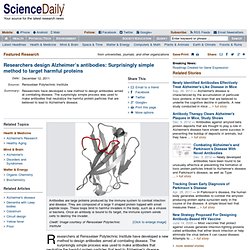
The surprisingly simple process was used to make antibodies that neutralize the harmful protein particles that lead to Alzheimer's disease. The process, reported in the Proceedings of the National Academy of Sciences (PNAS), could be used as a tool to understand complex disease pathology and develop new antibody-based drugs in the future. Antibodies are large proteins produced by the immune system to combat infection and disease. They are composed of a large Y-shaped protein topped with small peptide loops. These loops bind to harmful invaders in the body, such as a viruses or bacteria. Scientists have long sought methods for designing antibodies to combat specific ailments. When trying to design an antibody, the arrangement and sequence of the antibody loops is of utmost importance. A natural dye obtained from lichens may combat Alzheimer's disease.
A red dye derived from lichens that has been used for centuries to color fabrics and food appears to reduce the abundance of small toxic protein aggregates in Alzheimer's disease.
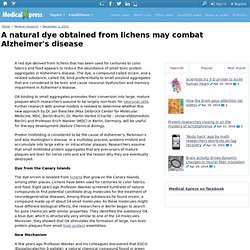
The dye, a compound called orcein, and a related substance, called O4, bind preferentially to small amyloid aggregates that are considered to be toxic and cause neuronal dysfunction and memory impairment in Alzheimer's disease. O4 binding to small aggregates promotes their conversion into large, mature plaques which researchers assume to be largely non-toxic for neuronal cells.
Further research with animal models is needed to determine whether this new approach by Dr. Jan Bieschke (Max Delbrück Center for Molecular Medicine, MDC, Berlin-Buch), Dr. Martin Herbst (Charité – Universitätsmedizin Berlin) and Professor Erich Wanker (MDC) in Berlin, Germany, will be useful for therapy development (Nature Chemical Biology.
Dye from the Canary Islands New Mechanism "This is a new mechanism," Professor Wanker explained.